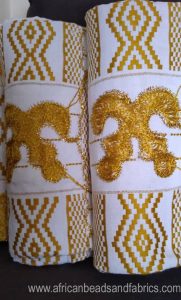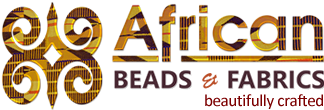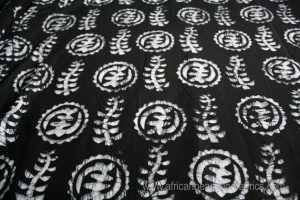Introduction
Adinkra is a traditional African fabric made by stamping or printing largely using local materials such as dye from plant extracts and stamps carved out of plant sources. Originally the cloth used for making Adinkra was hand–woven with hand-spun thread, woven on a Kente-style loom. This has all changed now and a mix of fabrics are used in making it. With new symbols and designs introduced regularly, Adinkra has become a dynamic phenomenon and lives on from generation to generation.
- adinkra cloth
- woven kente trim gives adinkra cloth a lift
A Bit of History
A popular account holds that King Adinkra of Gyaman, present day La Cote d’Ivoire (and Ghana’s immediate neighbour to the left), angered the King of Ashanti in Ghana by claiming to have the same Golden Stool as the one of the Ashanti Kingdom. The King of Ashanti considered this claim disrespectful. The resulting war in the early 1800’s, saw the King of Gyaman defeated and slain. The fabric King Adinkra was wearing at the time he was killed was part of the plunder. This cloth, now named ‘Adinkra’ by the victors after defeated king, was reproduced by Ashanti weavers, who learned the art from the Gyaman.
There are contesting claims concerning Adinkra being made much earlier than the 1800s. According to E. Appiah (1980) the Denkyira people were making Adinkra in the early 1700s. The earliest assortment of Adinkra found in the British Museum was collected by E. T. Bowditch in 1817 (Mack and Piction, 1989). Dr. J. B. Danquah also claims that Adinkra comes from the Akan language and is unrelated to other groups.
Usage and Symbolism
The Akan word “nkra” means “goodbye” or “farewell”, thus conveying a message. This makes sense as originally, the cloth was worn primarily as a funeral cloth by Ashanti royalty and traditional spiritual leaders. Its use is more diverse now occasions include child naming, marriage, installation of chiefs and queen mothers. The symbols are also incorporated into handwoven tradtional Kente to carry relevant messages.
Colours
Different types/colours of adinkra cloth exist. including:
- Kobene (brick red)
- Kuntukuni (dark brown)
- Brisi (black)
These three are mostly used as funeral cloths. Brisi cloth may be produced without symbols.

Kobene or red Adinkra
Men wear adinkra cloth like a toga, over the right shoulder. (see photo above). For women the fabric is made into stylish and traditional blouse and long skirt known locally as “slit and kaba”.
Lighter versions of adinkra are worn at weddings and other celebratory events. Kwasiada (Sunday) Adinkra is printed on a white background and used for festive or special occasions including attending church on a Sunday.
Symbols
The symbols in the Adinkra fabrics determine the occasions and places/locations to which the cloths are worn. For instance it is alleged that nobody dares to wear the “Aya” (meaning “I don’t fear you, and you don’t fear me”) Adinkra fabric to the Manhyia Palace which is the seat of the Ashanti chief.
Making Adinkra Cloth
A major center of traditional adinkra cloth production is Ntonso in the Ashanti Region of Ghana where our team visited to find out more about the process of producing this fabric.
The fabric is made by stamping strips of selected fabrics with traditional Akan symbols in dyes. The dye is made from the bark and roots of the badeε and kuntukuni trees which grow in the Savannah regions of Northern Ghana. The bark of the badeε is soaked, pounded and boiled to produce a thick dye known as the Adinkra aduro. This is used to dye the fabric to obtain the desired colour. A thicker version of the dye is used to stamp the fabric.
- badeε tree
- badeε tree bark
- badeε tree pulp
- pounding tree bark
- badeε tree dye
The Process
- Adinkra symbols are carved on to pieces of calabash (hard fruit of the calabash tree) to make a stamp and attached to a handle.
- Strips of cloth or fabric are laid on solid surfaces.
- First the fabric is divided into sections using a hard comb carved from local hardwood with two to eight prongs.
- The calabash stamps are then used to apply the adinkra symbols to the sections between the comb marks.
- The strips of stamped fabric then sewn together to form fabric of various sizes depending on the intended use.
- These strips are then hand- or machine- sewn to make adinkra cloth.
- gye Nyame
- aya
- Funtumfunafu denkyemfunafu
- akofena
- adinkrahene
- stamping in progress
- stamping is done entirely by hand
Other methods of adinkra cloth production include screen and machine printing. Kente strips or patterns can be incorporated into adinka cloth.
Adinkra symbols now appear in two other traditional Ghanaian fabrics, which are kente and batik.

adinkra symbol woven into kente fabric
The Results
- strips of the cloth left to dry
- completed large cloth
- large cloth drying on the grass
The adinkra symbols carry and send unique messages which is in sync with the highly communicative Ghanaian culture. We have discussed the different adinkra symbols and their meanings on a different page on this website.
Adinkra Symbols In Batik Fabric
- hye wo nhye (endurance)/Nyame nnuwu na mawu -immortality
- hand-printed cotton batik fabric
- sankofa symbols in batik fabric
Many in Ghana wear a cloth to convey a message, hence why various African fabrics are given names. Adinkra print fabrics are popular in Ghana.
Tourism
The Adinkra industry lives on as an important part of Ghana’s culture (just like the Kente fabric) and has become a tourist attraction. Efforts have been made to grow the “badeε” at the Ntonso Adinkra Tourist Center for tourists’ viewing purposes. The youth involved in the Adinkra industry plan to cultivate enough “badeε” trees and to stop harvesting from the wild in order to protect the environment as well as assure sustainability of the industry.
The Adinkra is produced and marketed in multiple locations across Ghana as producers and marketers alike make efforts to earn a living from the trade in areas where they establish demand for their products. The industry forms a major part of the socio-cultural and economic life of the people of Ntonso area in Ashanti and beyond, providing employment to a sizable portion of the population. The Adinkra industry lives on as part of Ghana’s culture and has also been developed into a tourist attraction in the Ntonso area.
Credit
All stories regarding the history of Adinkra, contesting claims of time origin and production process are based on interviews with the Ntonso Craft Village and Visitor Centre.



























